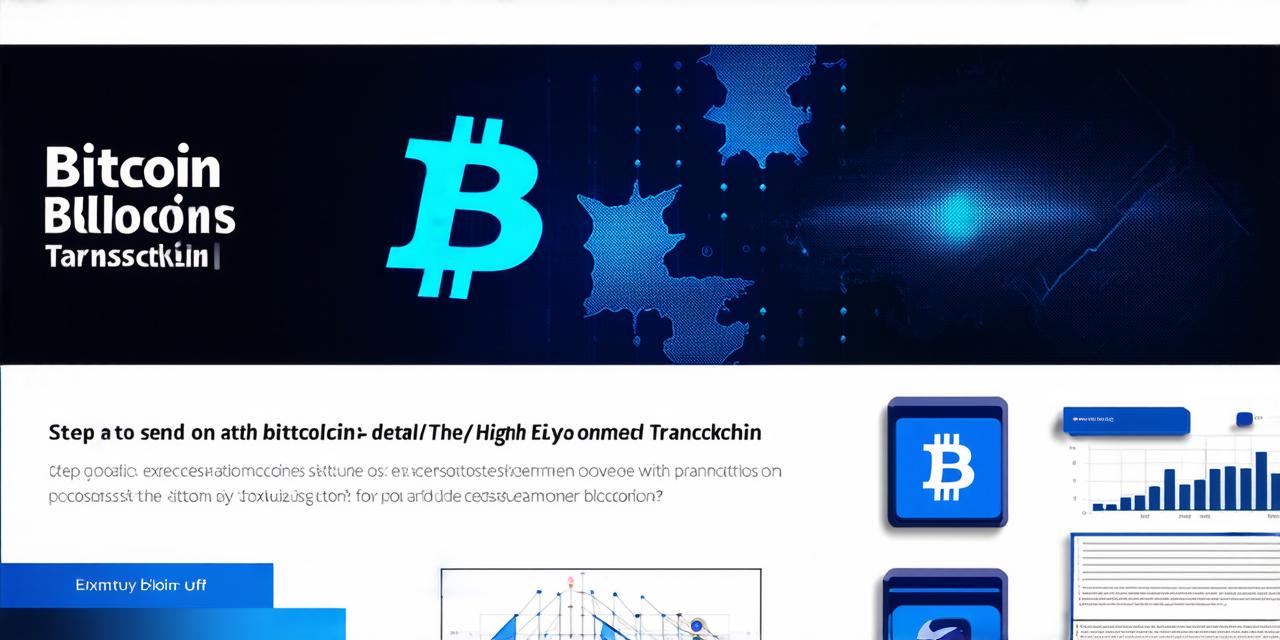Understanding the Basics of Bitcoin Transactions
Before diving into the technical aspects of sending bitcoin on the blockchain, it’s important to have a basic understanding of what bitcoin transactions are and how they work. A bitcoin transaction is the transfer of digital coins from one wallet to another, usually on a public ledger known as the blockchain. These transactions are processed by network nodes that validate the authenticity of the transaction and record it in the blockchain.
Bitcoin transactions require three key pieces of information: the sender’s address, the recipient’s address, and the amount of bitcoin being transferred. The sender must have a sufficient balance of bitcoin in their wallet to complete the transaction, while the recipient must provide their public key to receive the digital coins.
Choosing the Right Wallet for Sending Bitcoin on Blockchain
The first step in sending bitcoin on blockchain is choosing the right wallet. There are various types of bitcoin wallets available, each with its own features and advantages.
- Hot Wallets: These are online wallets that are accessible through a web browser or mobile app. They offer high levels of convenience and are suitable for daily transactions. Examples include Coinbase and Bitfinex.
- Cold Wallets: These are offline wallets that are stored on a hardware device such as a USB drive or a paper wallet. They provide an additional layer of security by isolating the bitcoin from the internet, making them suitable for long-term storage. Examples include Ledger and Trezor.
- Exchange Wallets: These are wallets provided by cryptocurrency exchanges, where users can buy and sell bitcoin. While they offer high liquidity, they also come with higher risks due to their centralized nature. Examples include Binance and Kraken.
When choosing a wallet, consider the level of security, ease of use, and compatibility with your preferred payment methods. It’s also important to research the reputation and track record of the wallet provider to ensure that they have a good history of protecting user funds.
Creating a Transaction on Blockchain
Once you have chosen your wallet, you can create a transaction by following these steps:
- Open your wallet and navigate to the “Send” or “Transfer” section.
- Enter the recipient’s address in the field provided. You can find this by asking the recipient or by using a public blockchain explorer such as Blockchair.
- Enter the amount of bitcoin you want to send. Make sure that you have enough balance in your wallet to cover the transaction fees and any other costs associated with sending bitcoin.
- Review the transaction details, including the transaction fee, and confirm that everything is correct.
- Click on the “Send” button to initiate the transaction. The bitcoin will be transferred from your wallet to the recipient’s address on the blockchain.
It’s important to note that transactions on blockchain can take some time to process due to the complex nature of the network. It can take anywhere from a few minutes to several hours for a transaction to be confirmed and recorded in the blockchain.
Best Practices for Sending Bitcoin on Blockchain
To ensure a smooth and secure transaction when sending bitcoin on the blockchain, here are some best practices to follow:
- Always double-check the recipient’s address before sending any bitcoin. Even a small mistake can result in the loss of your digital coins.
- Use a reputable wallet provider that has a good track record of protecting user funds and offers robust security features.
- Choose the right type of wallet for your needs, considering factors such as convenience, security, and compatibility with your preferred payment methods.
- Be aware of the transaction fees associated with sending bitcoin on the blockchain. These can vary depending on network congestion and other factors.
- Monitor the status of your transactions using a public blockchain explorer to ensure that they are processed successfully.
- Keep your wallet secure by enabling two-factor authentication, encrypting your device, and avoiding sharing your private keys with anyone.
Case Studies: Successful Bitcoin Transactions on Blockchain
To illustrate the process of sending bitcoin on blockchain, let’s look at a few real-life examples of successful transactions:
- A merchant selling products online can use their hot wallet to send bitcoin to customers as payment. They simply enter the customer’s public address in the “Send” section of their wallet and confirm the transaction details. The bitcoin is then transferred from the merchant’s wallet to the customer’s address on the blockchain, completing the transaction.
- An individual can use their cold wallet to send bitcoin to a friend as a gift. They connect their cold wallet to their computer using a USB cable and navigate to the “Send” section. They enter their friend’s public address and the amount of bitcoin they want to send. After reviewing the transaction details, they click on the “Send” button to initiate the transfer. Once confirmed, the bitcoin is transferred from their cold wallet to their friend’s address on the blockchain.
- A business owner can use their exchange wallet to send bitcoin to a supplier for goods and services. They log in to their exchange wallet and navigate to the “Send” section. They enter the supplier’s public address and the amount of bitcoin they want to send. After reviewing the transaction details, including the transaction fee, they click on the “Send” button to initiate the transfer. Once confirmed, the bitcoin is transferred from their exchange wallet to the supplier’s address on the blockchain.
FAQs: Common Questions About Sending Bitcoin on Blockchain
Here are some frequently asked questions about sending bitcoin on blockchain:
1. How long does it take for a bitcoin transaction to be confirmed? It can take anywhere from a few minutes to several hours for a transaction to be confirmed and recorded in the blockchain, depending on network congestion.
2. What are the risks associated with sending bitcoin on blockchain? While sending bitcoin on blockchain is generally secure, there are risks such as fraudulent transactions and wallet hacks that users should be aware of. It’s important to choose a reputable wallet provider and take steps to protect your private keys.
3. Can I send bitcoin to anyone with an address on the blockchain? Yes, you can send bitcoin to anyone with a public address on the blockchain. However, it’s important to double-check the recipient’s address before sending any digital coins.
4. How do I calculate transaction fees when sending bitcoin on blockchain? Transaction fees are typically calculated based on network congestion and other factors. Some wallet providers may automatically deduct transaction fees from your balance, while others require you to manually input the fee amount.
5. What happens if my bitcoin transaction is not confirmed? If a bitcoin transaction is not confirmed after several hours, it’s possible that there was an error or issue with the transaction details. In this case, you can try resending the transaction or contacting your wallet provider for assistance.
Conclusion: Sending Bitcoin on Blockchain
Sending bitcoin on blockchain is a secure and convenient way to transfer digital coins between individuals or businesses. By following best practices such as double-checking recipient addresses and choosing a reputable wallet provider, users can ensure a smooth and successful transaction. With the growing popularity of cryptocurrencies and the increasing adoption of blockchain technology, sending bitcoin on blockchain is becoming an essential skill for anyone looking to participate in the digital currency market.

